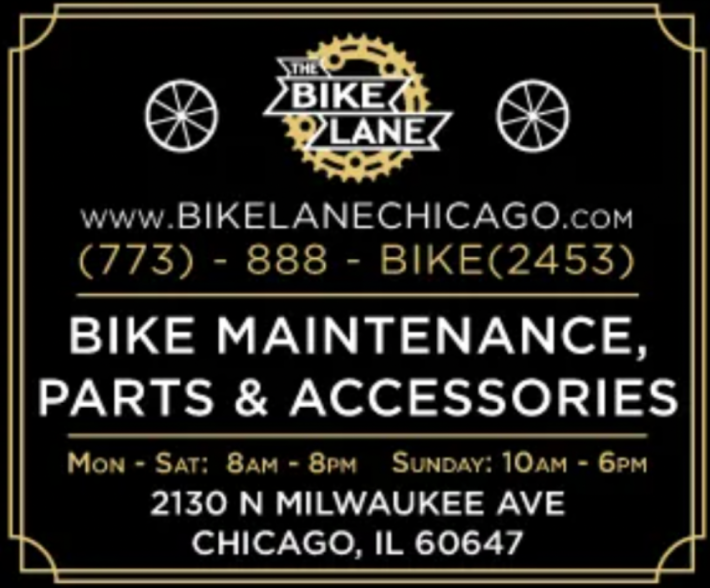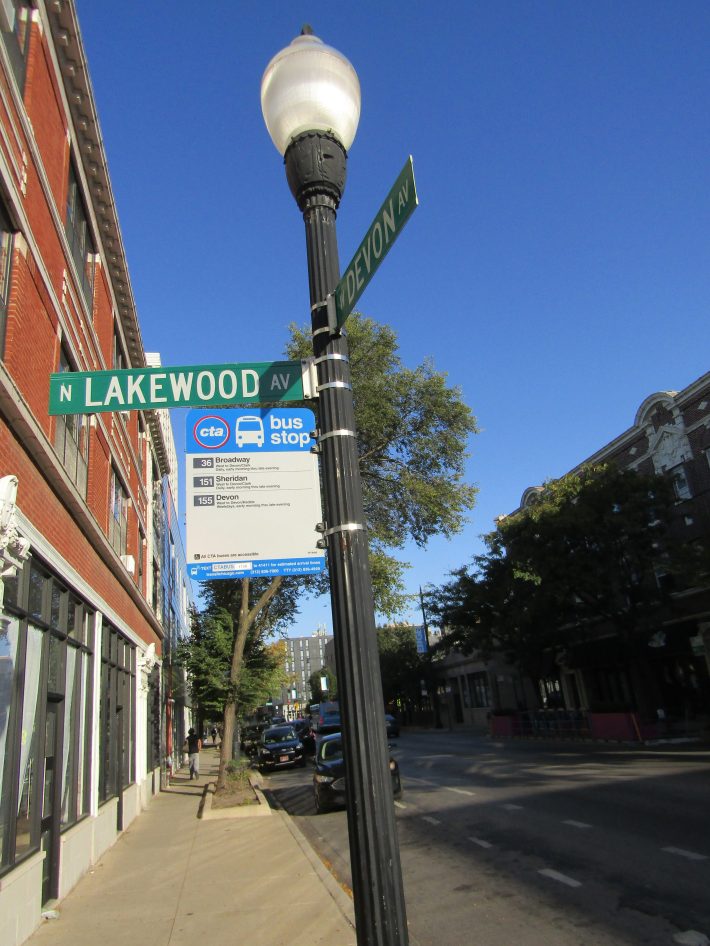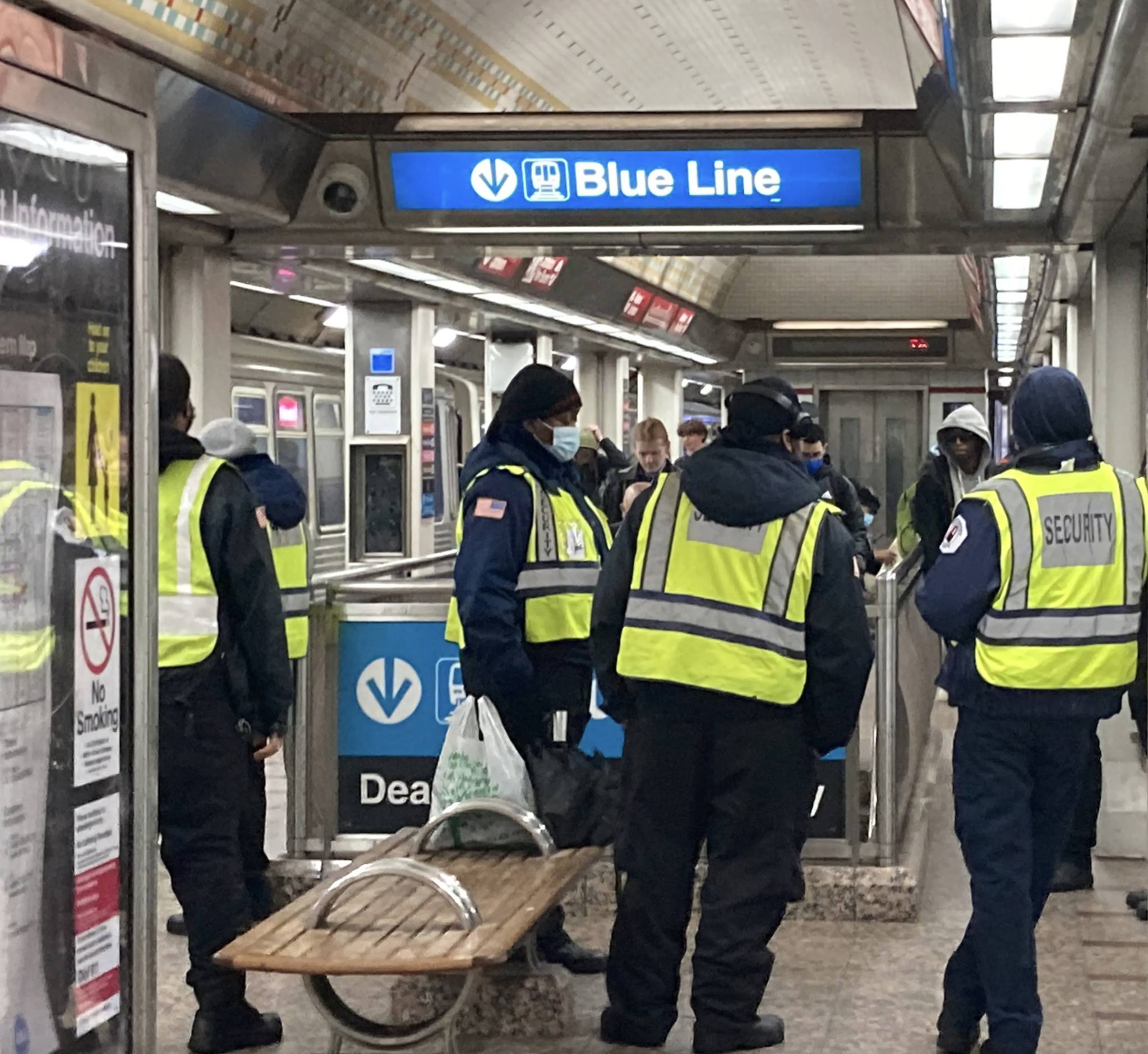
On Wednesday during its monthly meeting, the CTA board signed off on a pilot that could take digital signs where they’ve never gone before. And a seemingly routine vote on to put out a request for proposals for a new security guard contract led to a long discussion of whether the system’s current security measures were effective, or if the money would be better spent elsewhere.
Digital signs pilot
Under a new pilot program, the CTA will contract Global Display Solutions Inc. and Papercast North America to put up digital bus stop signs at 20 stops throughout the city. The signs will show real-time arrival information and route announcements such as reroute information. Up to this point, the transit agency only installed digital signs on bus shelters and at 'L' stations. The new signs will go up on the same poles as bus stop signs.
In late 2023, the CTA launched the Innovation Studio initiative to develop ideas for pilot projects that improve rider experience. Cara Bader, the agency’s vice president of innovation, said that the digital sign pilot is one of the several pilots that were developed as the result. "We do see a lot of demand from our riders for real-time information," she said
The CTA chose GDS and Papercast out of 31 vendors that submitted applications. Bader said that they chose two vendors because they wanted to test solar-powered signs and battery-powered signs, but she didn’t specify which company will provide which. And while the two types of signs will be different sizes, they will be small enough to be mounted onto the poles. The two companies will be paid $55,000 each.
Bader said the CTA is still deciding on the digital sign locations. They are looking at busy locations; corridors that get regular detours due to events (certain stretches of Michigan and Devon avenues might qualify); transfer points and stops where "bus shelters are unlikely to come in the future." With solar-powered signs, the agency wants to make sure they get "sufficient sun exposure."

After the meeting, CTA spokesperson Catherine Hosinski told Streetsblog that the majority of CTA stops don’t have bus shelters. If this initiative moves beyond the pilot, it would give bus riders something 'L' riders already have – real-time arrival displays at every stop.
Hosinski also said the displays would be a better way to alert riders about detours. The CTA currently has to rely on paper notices taped to bus stop poles, and there’s nothing that stops someone from tearing them off or defacing them. And it’s not unusual for detour notices to stay taped on the poles days, if not weeks, after detours are over.
Notably, the CTA still uses SMS-based bus tracker alerts. Every bus stop sign has a stop number and lists the number customers can text "CTABUS [bus stop number]" to for arrival times. After you get a reply, if you respond by texting capital "S," you'll get service alerts for the route. But having this information displayed on a digital bus stop sign would be more intuitive.
During the meeting, Bader said the CTA hopes to get the pilot started by this December or January. She said the launch would depend "on how quickly we can move through shipping and get materials on site" in order to test the technology during the depths of winter.
Board member Roberto Requejo said that he hopes that the South and West sides won’t be left out of the pilot, and he hoped that the test will include stops frequented by senior citizens, who are less likely to use smartphones.
Board member Rosa Ortiz said she wants to make sure the Northwest and Southwest sides don’t miss out either. She added that she wants the alerts to be displayed in multiple languages – something that’s easier to do with digital signs than paper ones. While some CTA notices are released in multiple languages, English is still a default. She said she wants to see the CTA "really thinking about how and why this information can be translated into many languages used throughout the city." I think it would be very helpful.”"
Bader said that they will try to distribute the signs equitably. "20 is not a lot, but we also understand that we don't have unlimited check in the program."
Security concerns
Concerns about safety on CTA buses and 'L' trains have grown since the COVID-19 pandemic. They intensified with the execution-style murders of four people sleeping on the Blue Line last Labor Day. Security has been a recurring topic at the transit agency's board meetings.
On Wednesday, the board was asked to sign off on funding for the request for proposals for the new contract for unarmed security guards. The CTA is budgeting $26 million for the guards, but the actual sum will depend on the lowest qualified bid. The current contract expires in April 2025.
Roberto Requejo said that he wants the CTA "to build upon the lessons that we have learned in the past few years, to move above and beyond the binary of armed police and unarmed guards, and think about community engagement." Other possibilities he mentioned included transit ambassadors, support services for unhoused people, crisis intervention teams, and improving the "physical environment" around the station, such as upgrading lighting.
Nancy-Ellen Zusman, the CTA's chief safety and security officer, responded that "We are looking at those things," as well as technology that could improve security, such as what’s in place at Wrigley Field. This particular vote, she said, just happened to be only about the security guards contract. "We’re not just looking at it [through] the narrow scope of more guards and more police, but are there other things we can do to address security and safety issues."
Requejo replied that he appreciated hearing that, but said the CTA keep in mind community organizations that could be part of the solution. "Communities often know better than experts [about] security, what works best for their particular locations, etc., and I feel that we can do more engaging community organizations, civic sector, in helping us figure out the issues that we have in our system." He added that having more CTA staff at the stations could make them safer.
Ortiz echoed Requejo’s call for a multi-faceted approach. "If I see someone with [a weapon], whether that’s a police officer or someone else, that doesn’t actually make me feel safer. It actually makes me feel like we’re in a really dangerous place."
While Ortiz said she knows the CTA is working toward other solutions, "It would be helpful to know when and how we could implement those components, because we are putting money in, and I think it would be helpful for all of us to know exactly where and how those funds are going to be distributed."
Board Chair Lester L. Barclay said that CTA ridership won’t rebound to pre-pandemic numbers until riders and employees feel safe. "Just pouring more and more money into security without seeking some real results in terms of change" and "spinning our wheels" won't help, he said.
"Unarmed security guards – how effective are they?" Barcley asked. “We’ve been testing this out for a period of time. We need to know the degree of effectiveness that exists."
Barclay said he doesn't share Ortiz's opinion that presence of armed security makes transit feel dangerous. "When people see police, they have a greater sense of safety, as I perceive it," he said. “So, for me, it’s simply that we don’t see enough armed police officers on our trains. We don’t have what New York has, where they see them. People seem to have a little more respect and be more accountable when they see a little authority."
Ortiz responded that, given well-documented biases in the justice system, she was wary of relying too much on armed security. "I’ve been in Mexico, in very hard, dangerous areas where everyone is armed, that still hasn’t felt comfortable for me," she said.

Zusman said the CTA is "exploring all options," including bringing back the dedicated CTA police department. In the meantime, she said, the agency does look at what works and what doesn’t, "adjusting guard coverage" where necessary.
"We found that K-9s [guard units with attack dogs] are more effective as a team, so we’re going to switch locations with the K-9s and reduce some of the armed guards," she said.
"Safety is paramount, and exploring the plans is not enough," argued board member Michele Lee. "You have to come to us with solutions." She added that she doesn’t want CTA to be "stuck in the circle of conversation that isn’t getting us anywhere."

Did you appreciate this post? Please consider making a tax-deductible donation, to help keep Streetsblog Chicago's sustainable transportation news and advocacy articles paywall-free.





